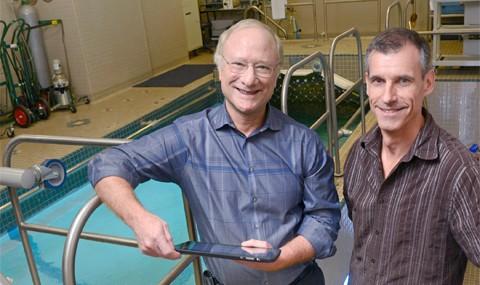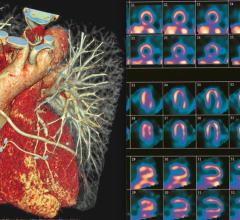
UTSW cardiologist Dr. Benjamin Levine, left, will use NASA-honed technology to monitor swimmer Ben Lecomte in his record-setting goal to become the first person to swim across the Pacific Ocean. Image courtesy of UT Southwestern.
September 21, 2015 — University of Texas Southwestern cardiologist Benjamin Levine, M.D., will use NASA-honed technology to monitor swimmer Ben Lecomte in his record-setting goal to become the first person to swim across the Pacific Ocean. Lecomte will plunge into the ocean off of a Tokyo beach this summer heading for San Francisco.
Levine, a renowned sports cardiologist who holds the Distinguished Professorship in Exercise Sciences at UT Southwestern, is hoping to study the effects of the endurance swim on Lecomte’s heart.
“This is a continuation of our work and our interest in the effects of extreme conditions on the human body,” said Levine, professor of internal medicine and director of the Institute for Exercise and Environmental Medicine at Texas Health Presbyterian Hospital Dallas. The hospital is the result of a partnership between UT Southwestern and Texas Health Resources that studies human physiology across the life span, especially physiology under extreme conditions.
One of the current controversies in cardiology is whether extreme athletic performance has a harmful effect on the heart. Despite the demands of Lecomte’s swim, Levine anticipates no negative effects on the swimmer’s heart.
Levine, who was part of NASA’s Specialized Center of Research and Training and the Human Research Facility (Space Station) Scientific Working Group, will use NASA-tested technology called remote guidance echocardiography to monitor changes to Lecomte’s heart during his swim. The technology is the same used to monitor astronauts on the International Space Station.
Echocardiography uses high-pitched sound waves that are bounced off the heart. Echoes of these ultrasonic waves are picked up by the machine and translated into a video image of the beating heart. Echocardiograms are usually performed by trained sonographers, but the remote guidance echocardiograph technology allows a sonographer to guide a modestly trained individual through the process in remote locations such as the International Space Station, a small village in Mozambique or the middle of the Pacific Ocean.
Using this same technology, Levine and colleagues recently completed a seven-year study of the hearts of 13 astronauts who were living on the International Space Station. That study examined the impact of long-term microgravity on heart function.
“This is the ultimate in telemedicine. The astronauts spend a few hours training and practicing using echocardiography in the Space Station mock-up at Johnson Space Center. Some of them are really into it. I wouldn’t have thought it possible, but you get research-quality images,” said Levine, who holds the S. Finley Ewing Jr. Chair for Wellness and the Harry S. Moss Heart Chair for Cardiovascular Research at Texas Health Presbyterian Dallas.
Levine’s lab already began the research on Lecomte by taking baseline echoes of his heart.
“He’s lean and has a nice big heart that comes right up against the chest, so we took some beautiful two- and three-dimensional images, which will serve as a baseline for during and after his swim,” Levine said. “It looks fantastic. It’s large – appropriately so – and strong. It beats normally.”
Lecomte, a longtime Grand Prairie resident who recently moved to Round Rock, Texas, is a record-setting endurance athlete who was the first person to swim across the Atlantic Ocean. He is now looking to become the first to swim across the Pacific Ocean, with the goal of bringing attention to environmental issues.
For more information: www.utsouthwestern.edu


 January 23, 2024
January 23, 2024 








